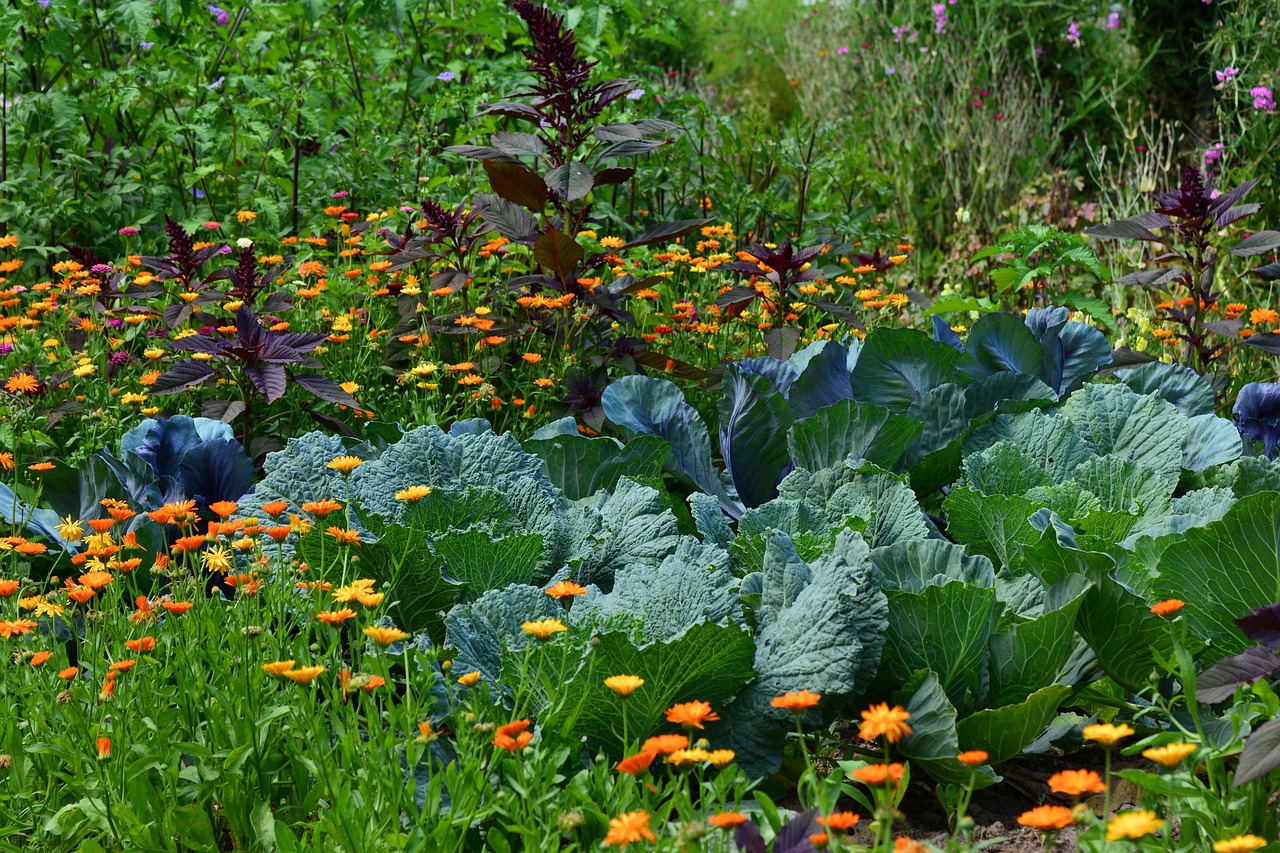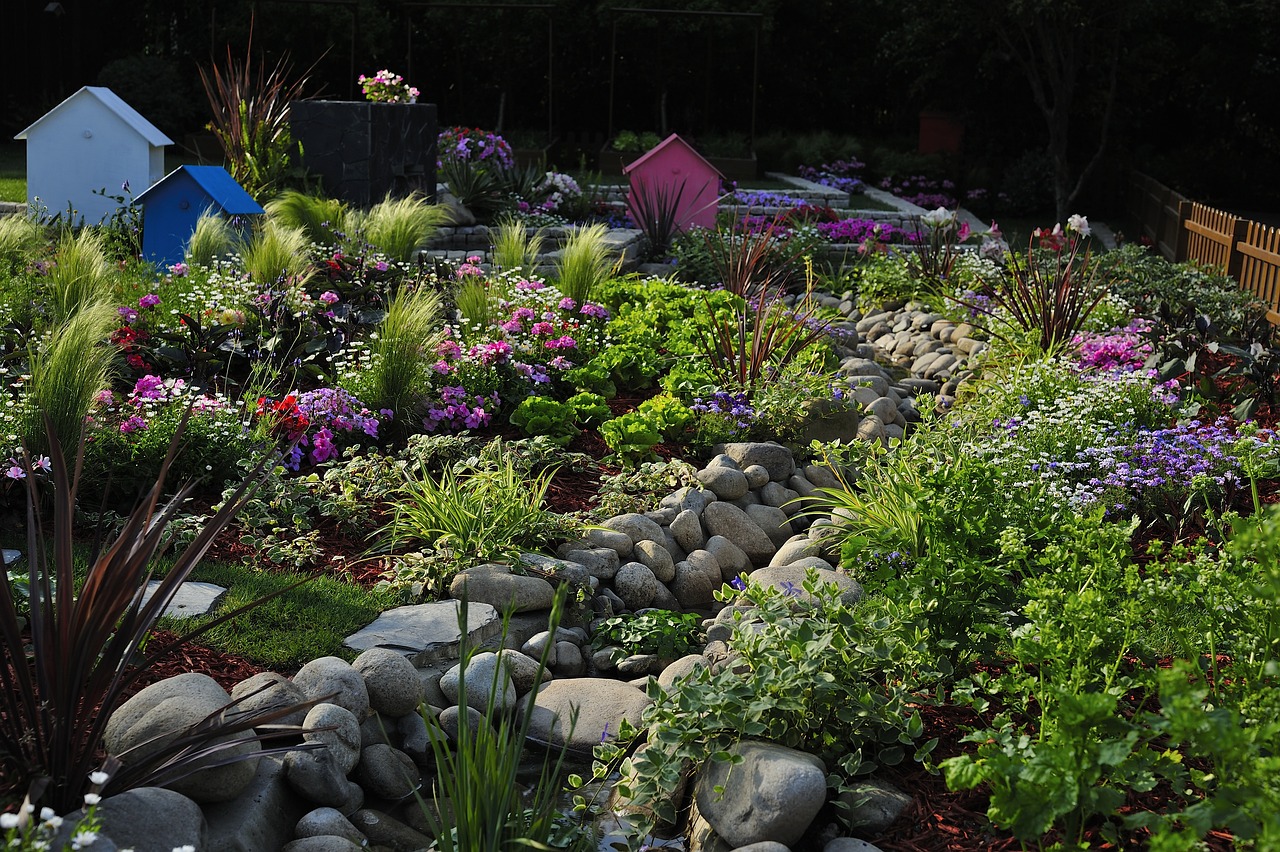In previous posts, I covered gardening indoors and on a balcony or patio. But what if you have a yard, but it’s tiny? Just like you an grow a surprising amount of food on a balcony, you can grow even more on just a postage stamp-sized piece of land (and, of course, you can combine your yard garden with a patio or indoor gardening).
This California family has the flagship of urban gardens. The Dervaes live in a historic neighborhood in Pasadena, CA on a standard-size, 1/4 acre lot. But they grow enough to feed 4 adults a vegetarian diet, plus they sell about $20,000 a year in excess produce to local restaurants. Besides the garden and orchard, they also keep bees, chickens and ducks, and miniature goats. (If you’re wondering about ordinances regarding livestock, hens—but not roosters—are often allowed inside city limits, and miniature animals, like Nigerian pygmy goats, may slide under the heading of “pet.”)
While this sort of urban garden seems alien to us today, their 100 year old house probably has had many gardens in the backyard over its lifetime. Gardening, even in cities, used to be standard. My stepfather was born in 1941 and grew up in Chattanooga in a similar sort of neighborhood as the one featured, and his family always had a garden in the backyard. They weren’t uncommon before the War, they were everywhere during it, and for quit a long time afterwards, they remained present.
What if most of your limited yard space is taken up by an unused swimming pool? That, too, can be repurposed into a garden. This family put a greenhouse over their swimming pool. Above the pool at one end, they put chickens. Below the chickens they retain enough water in the deep end to keep tilapia. The chickens’ manure stimulates the growth of algae, which feeds the fish. (They also grow duckweed on the surface of the water, which fish and poultry will both eat and which is an edible green for humans.) They pump the fertilized water out of the fish pond and use that for aquaponics gardening around the dry portions of their pool and backyard, then cycle the plant-filtered water back to the fish. (You can also just use the fish water in drip irrigation for plants in soil, if you don’t want to set up a full aquaponics system; you will just need to supply more clean water to the fish.)
This lady’s gardening channel is all about starting a garden later in life (you’re never too old to start). She appears to have a standard-size lot in Los Angeles, but it’s hard to tell because her yard and driveway are so densely planted, it’s not possible to see the house. (I can only think of one other person I know with a yard planted this densely, but not all of her plants are edible.)
She does seem to have a greater-than-average amount of damage to her crops caused by birds. I know my mother’s garden suffered from severe deer and chipmunk damage that I have never had, despite the fact that I live in a clearing in the middle of the woods. The difference, however, is that she’s on the side of a mountain; there’s nothing but woods in a very large area. My woods, however, are broken up by large pastures and rural homes. I think that the deer and other critters in my area simply have enough to eat in the surrounding yards (including my own) and pastures that it’s not worth the risk to them to come up to my house where my vegetables are. This lady may suffer from the same situation in that her neighborhood and those surrounding her are a food desert for birds, so her garden is the only source of food for them in the area.
This lady is documenting learning how to garden in her small, urban backyard. Like a lot of people, she started dabbling in gardening during Covid and has loved it enough to continue. In her channel intro she writes: “I’m a working mother of two, a dog, 7 chickens and 12 quail. I live in a vintage home in zone 7B. My urban “farm” occupies more than half of my backyard. It consists of 10 mixed planting spaces from raised beds to no dig beds to containers.” So, like the Dervaes in Pasadena, CA, Asia also has some backyard livestock.
This is a tour of an extremely small backyard garden in London. And, in fact, the owner says that the space is actually concrete, but he’s installed raised beds, containers, and covered the walkways with woodchips, so it feels like a proper garden.
The garden is 26’x16’, or a total of 416 sf. In this area, however, he’s growing about 617 lbs of food. Just like with balcony gardens, there is an extreme emphasis on vertical growing, because it’s really all the space he has.
This timelapse video shows the transformation of a very small urban backyard into a vegetable garden.
One thing I would disagree with him on is the use of rocks in his pathways. Rocks are actually not a bad idea in certain circumstances, like desert climates (rocks act as dew collectors, helping keep the soil moist for longer) and cold climates (rocks—especially dark ones—hold onto heat they collect during the day and radiate it at night, which will actually raise the air temperature around the surrounding plants. But in most cases, woodchips are the better option for pathways. They break down into rich dirt over time, so you can actually make compost where you’re walking. Nutrients also leach out of them and into the surrounding soil (even with a weed barrier in place), like a slow-acting compost tea, which boosts nearby plants. Woodchips also absorb a lot of water, so they’re a must-have if you have areas of your yard that flood or are soggy when it rains a lot. Make your woodchips several inches deep in these areas and you shouldn’t have to worry about your garden walkways being wet.
By the way, if you find yourself in need of tools to transform your backyard, like a sod cutter, roto-tiller, or woodchipper, check for your nearest equipment rental store. Renting equipment for a one-time or once-per-year job is way cheaper than buying it and, more importantly for a small space, it keeps you from wasting space storing it the 364 days it’s not in use.
Also, if you have a way to haul stuff (Lowe’s and Home Depot now rent out tow trailers, and most SUVs can handle pulling a small trailer and a scoop of dirt), it’s much, much cheaper to buy your dirt, compost, mulch, rocks, etc. in a large quantity from a landscape supplier. I have one in my area and a scoop of garden soil that fills up the back of my small truck costs about $40 and will do all the garden beds I can manage to make in a year. If I was buying it bagged from a home improvement store, I would probably only get a tenth of the amount of dirt for the same price. So, even if you have to rent a trailer for the day, you’ll still save money.
And while you’ve got that trailer, check to see if your city has a place where you can pick up mulch from where they do tree trimming cleanups. Tree removal services also many have free mulch available if you’re willing to load it (although some may load it for you if you make an appointment to pick it up). If you live in the country, like me, keep a beady eye out for the electric company coming through to trim the power lines once every year or two, and have them dump their truck load of mulch out in your yard.
This gentleman has a dense garden in the postage stamp front lawn that is typical for British houses. His area was also paved, so he’s used containers to grow his plants. He’s also made interesting use of stacks of pallets and even old wooden ladders to add height and interest to his garden. He’s also mixed in a few flowers for the bees and for looks, but at least some of his flowering plants, like borage, are also edible. I think he’s done a good job of having a dense planting that still manages to look appealing from the street.
As mentioned in the post on growing indoors, he’s also using some of his outdoor space for microgreens. He, at least partially, saves his own seed for planting, and he mentions using some of his old seed for microgreens. When seeds don’t have good germination rates, they are often not worth the effort of trying to grow unless you can densely seed them as microgreens, where you can potentially get enough produce to make it worth the effort. This is also a way to use up seeds for varieties you’ve determined you don’t like. Pepper plant that’s too hot? Turnips that are too bitter? Take your leftover seeds and make microgreens out of them.
Are you interested in learning more about gardening in challenging conditions? Check out this post: Growing Resilience: Victory Gardens for Everyone


